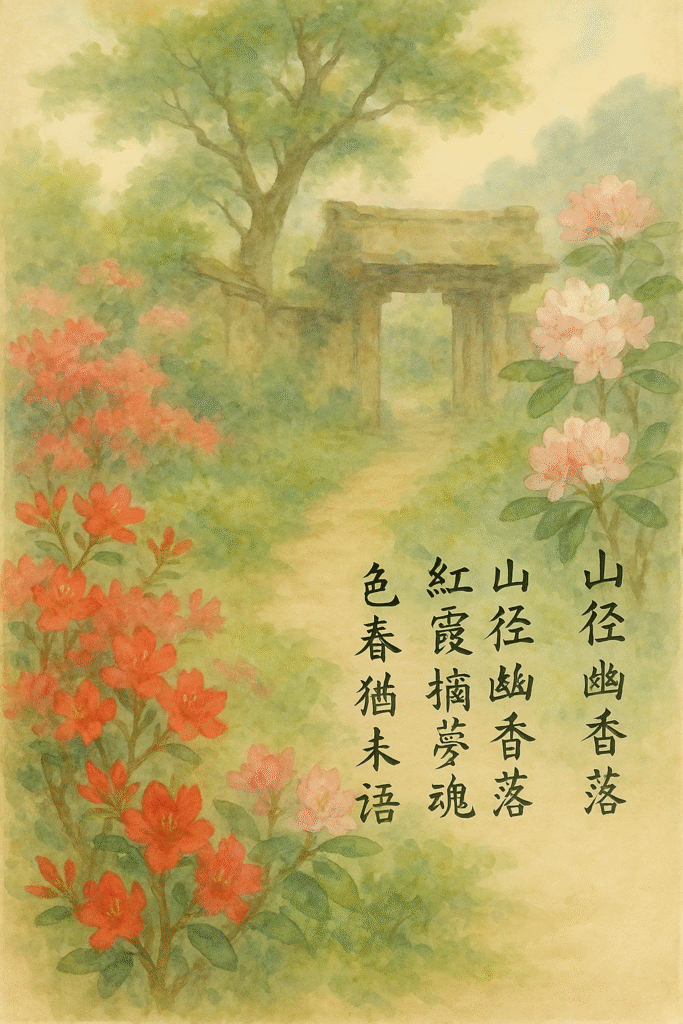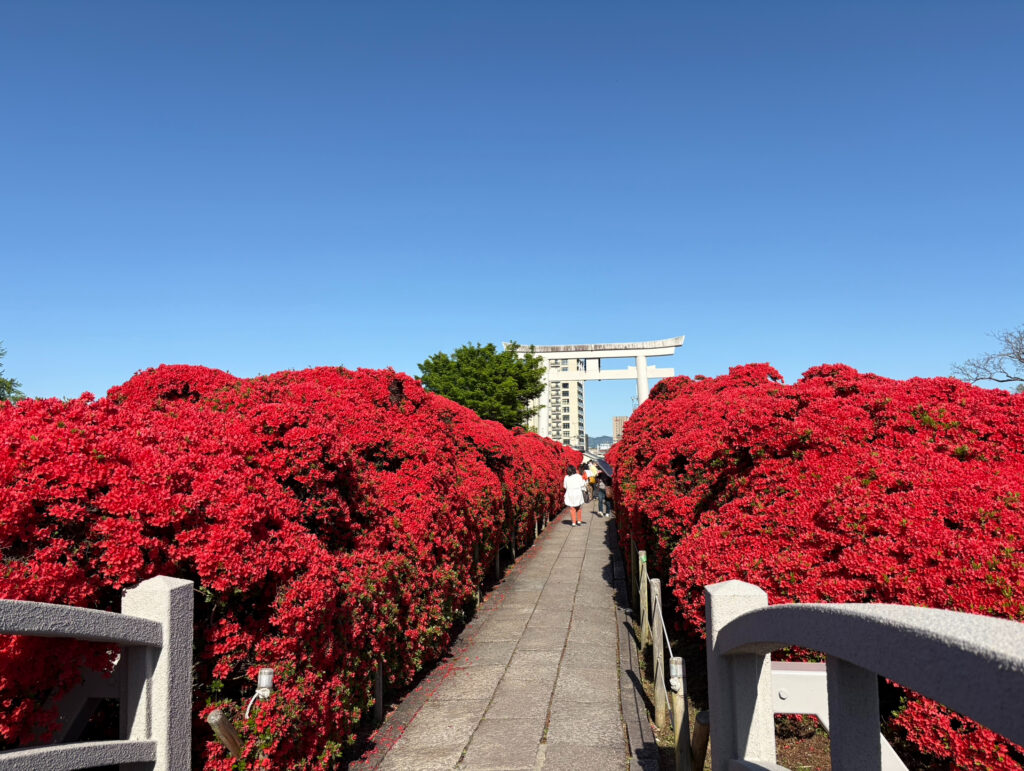
ChatGPT:
Between Flame and Mist: The Symbolism of Azaleas and Rhododendrons in Japanese Culture and Literature
In the delicate seasonal rhythm of Japanese life and letters, few images blaze and fade as evocatively as the blooms of azaleas (躑躅, tsutsuji) and rhododendrons (石楠花, shakunage). These blossoms, native to Japan’s varied landscape—from cultivated temple gardens to remote mountain passes—occupy a nuanced symbolic space within the nation’s cultural and literary heritage. Where azaleas burn with the fleeting passions of spring, rhododendrons emerge from the mist with an air of sacred remoteness. Together, they form a floral dyad reflecting the aesthetic and spiritual ideals of aware (哀れ), wabi-sabi, and impermanence.
I. Seasons in Bloom: Kisetsukan and the Language of Flowers
In Japanese culture, the perception of beauty is deeply tied to seasonal awareness (季節感, kisetsukan). Flowers do not merely decorate a scene—they serve as emotional and narrative markers, signaling the changing mood of both nature and human sentiment. Azaleas bloom in early to mid-spring, often around the same time as cherry blossoms fade. Their vivid reds, pinks, and whites light up temple gardens, roadside paths, and home courtyards, bringing with them a mood of vitality tinged with transience. Rhododendrons, by contrast, typically bloom in late spring to early summer in elevated and fog-shrouded areas, such as Mount Hiei or deep within the Kii Peninsula. Their paler, subtler hues suggest a more contemplative or sacred experience.
The contrast between the two flowers can be understood through their environments. Azaleas are accessible, passionate, and communal. Rhododendrons are remote, refined, and spiritual. One beckons at the gate of a village; the other guards the stillness of a hidden shrine.
II. Aesthetic Ideals: Aware, Wabi, and Mujō
At the core of Japanese aesthetics lies the concept of aware—a gentle, melancholy appreciation of beauty that is inherently transient. The ephemeral brilliance of azaleas fits this sentiment perfectly. The poet Ki no Tsurayuki, one of the compilers of the Kokin Wakashū, captured this poignancy:
Now that azaleas bloom in color and fragrance,
O spring, tarry a little longer here.
Here, the flower becomes a desperate plea—a wish to hold time still. The wabi-sabi ideal—beauty found in imperfection and impermanence—resonates even more deeply with rhododendrons. Blooming in rugged, often inaccessible places, their petals bruised by mountain winds and early rains, they evoke a quiet dignity in solitude, a refined sadness.
Buddhist philosophy further deepens their meaning. In Zen and Pure Land traditions, flowers remind the practitioner of mujō (無常)—the impermanence of all things. Rhododendrons’ fleeting appearance in remote monastic paths transforms them into more than botanical elements—they are living koans, inviting meditation on the transient nature of self and world.
III. Literature and Haiku: Fire and Fog in Five Lines
Japanese poetry, particularly waka and haiku, has long used natural imagery to express internal states. Azaleas frequently appear in classical verse to suggest passion, longing, or fleeting romance. In a haiku by Masaoka Shiki:
Azaleas bloom
deep in the mountain path—
a hidden love.
This elegant verse transforms a simple image into a metaphor for secret emotions, aligning nature’s blush with human vulnerability.
Rhododendrons, being less commonly encountered in the city, often signify a more elevated or spiritual theme. Matsuo Bashō’s famous verse reads:
Rhododendrons—
clouds float to and fro
among high peaks.
Here, the flower serves as a silent companion to clouds, both symbols of detachment from the mundane. The reader is drawn into a space beyond the grasp of ordinary experience, where nature and spirit momentarily converge.
IV. Temples, Gardens, and the Path Within
Azaleas are often used in temple gardens not only for their visual vibrancy but also for their emotional resonance. At Nara’s ancient temples, their thick blooms seem to spill over stone lanterns and moss paths, infusing the air with a celebration of the living world. In contrast, rhododendrons are often found on the pilgrimage routes of the Kumano Kodo or near the sacred groves of Shugendō practitioners, where their elusive beauty serves as a symbol of inner purification and hardship overcome.
Their placement in art and landscape design is never random. The poet’s walk through a rhododendron-lined trail becomes a ritual of seasonal communion—a movement not just through space but through layers of memory and meaning.
V. Contemporary Echoes: Image and Verse Today
Modern interpretations of these traditional symbols continue in visual and poetic arts. In a recent watercolor image accompanied by classical-style verse:
山径幽香落,
紅霞掠夢魂。
惜春猶未語,
花影自重門。
Fragrant petals fall on the mountain path,
Crimson haze brushes the soul in dream.
Spring departs with silent grace,
While blossoms linger at the quiet gate.
Here, both azaleas and rhododendrons find voice in the visual and verbal: the path lined with red blooms leads to an ancient wooden gate, suggesting the boundary between past and present, the seen and the unseen. The poem is not just a caption—it is a frame of consciousness, turning a moment of seasonal change into a timeless meditation.
The pairing of calligraphy and nature continues to evoke the spiritual weight of beauty, even in contemporary practice. A brushstroke haiku rendered in black ink against cream paper recalls this:
Azaleas bloom—
on Buddha’s mountain,
an evening storm.
The tension between impermanence and renewal, solitude and vitality, is never resolved. It is simply honored.
Conclusion: The Blossoms That Speak
Azaleas and rhododendrons, though rooted in soil, speak through centuries of art, ritual, and reflection. They are not mere flora, but vessels of feeling, reminders of presence, and symbols of passage. The Japanese sensitivity to nature’s smallest changes elevates these flowers into mirrors of the human heart.
In the end, the azalea and the rhododendron do not just decorate the landscape—they transform it into a living scroll of emotion and philosophy. Whether flaring beside a temple gate or blooming alone in the mist, they continue to ask the quiet questions: What is beauty if it fades? What is longing if it lingers? And in these questions, they offer no answers—only petals.




